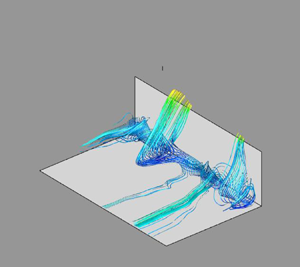Article contents
Low-dimensional analysis and modelling of the flow over a forward-facing step
Published online by Cambridge University Press: 28 November 2024
Abstract

We consider the direct numerical simulation of the flow over a forward-facing step protruding in a turbulent boundary layer. Proper orthogonal decomposition (POD) is applied to the velocity field in different regions using Fourier modes in the spanwise direction. The upstream flow is characterized by a structure with a spanwise modulation of the order of the step height, the origin of which is consistent with a centrifugal instability. The structure is associated with ejections over the step of low-speed fluid from the upstream recirculation, and organized into streaks through the action of strong spanwise motions along the step face. The spanwise-averaged instantaneous momentum deficit created by the ejections is directly related to the maximal shear rate at the edge of the step, and is well correlated with the dynamics of the downstream recirculation. The most energetic patterns consist of three-dimensional motions with a large spanwise wavelength located in the shear layer developing at the edge of the step, as well as two-dimensional fluctuations downstream of the reattachment. A linear model based on the interaction of the mean flow with the dominant POD modes is able to recover the main frequencies of the fluctuations at these wavenumbers. Including the time variations of the ejections into the model yields temporal spectra that resemble qualitatively those computed from the simulation. The results suggest that the global dynamics of the flow are at least partly driven by linear mechanisms and depend on the characteristic structure identified in the upstream region close to the step.
- Type
- JFM Papers
- Information
- Copyright
- © The Author(s), 2024. Published by Cambridge University Press
References
A correction has been issued for this article:
- 1
- Cited by
Linked content
Please note a has been issued for this article.



